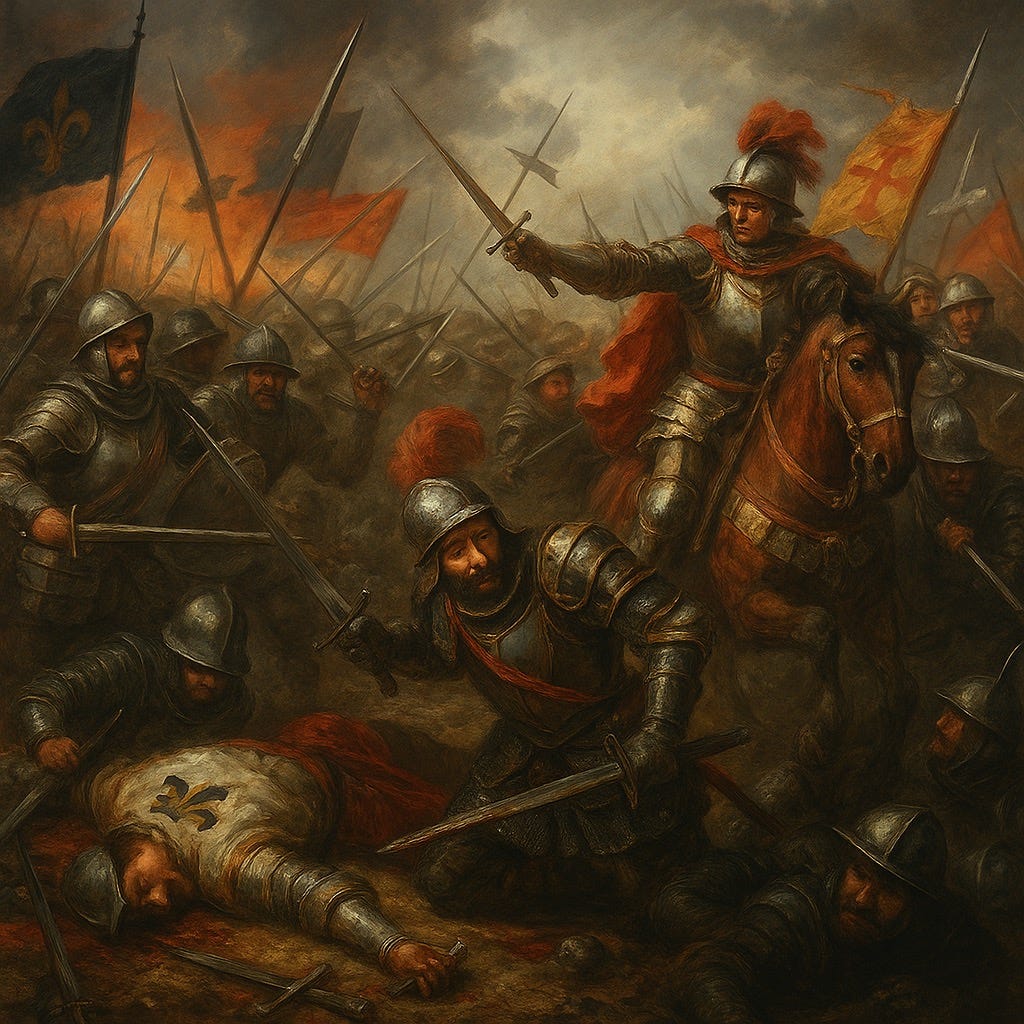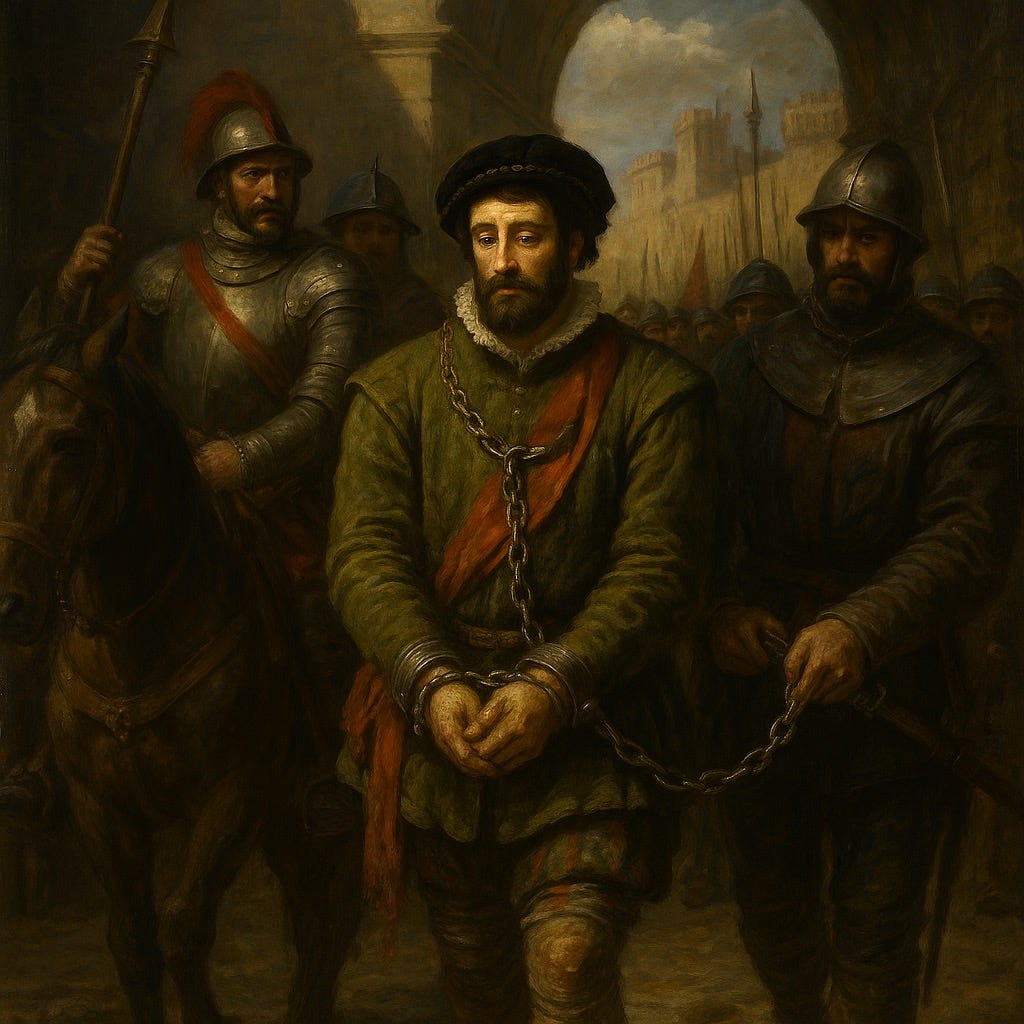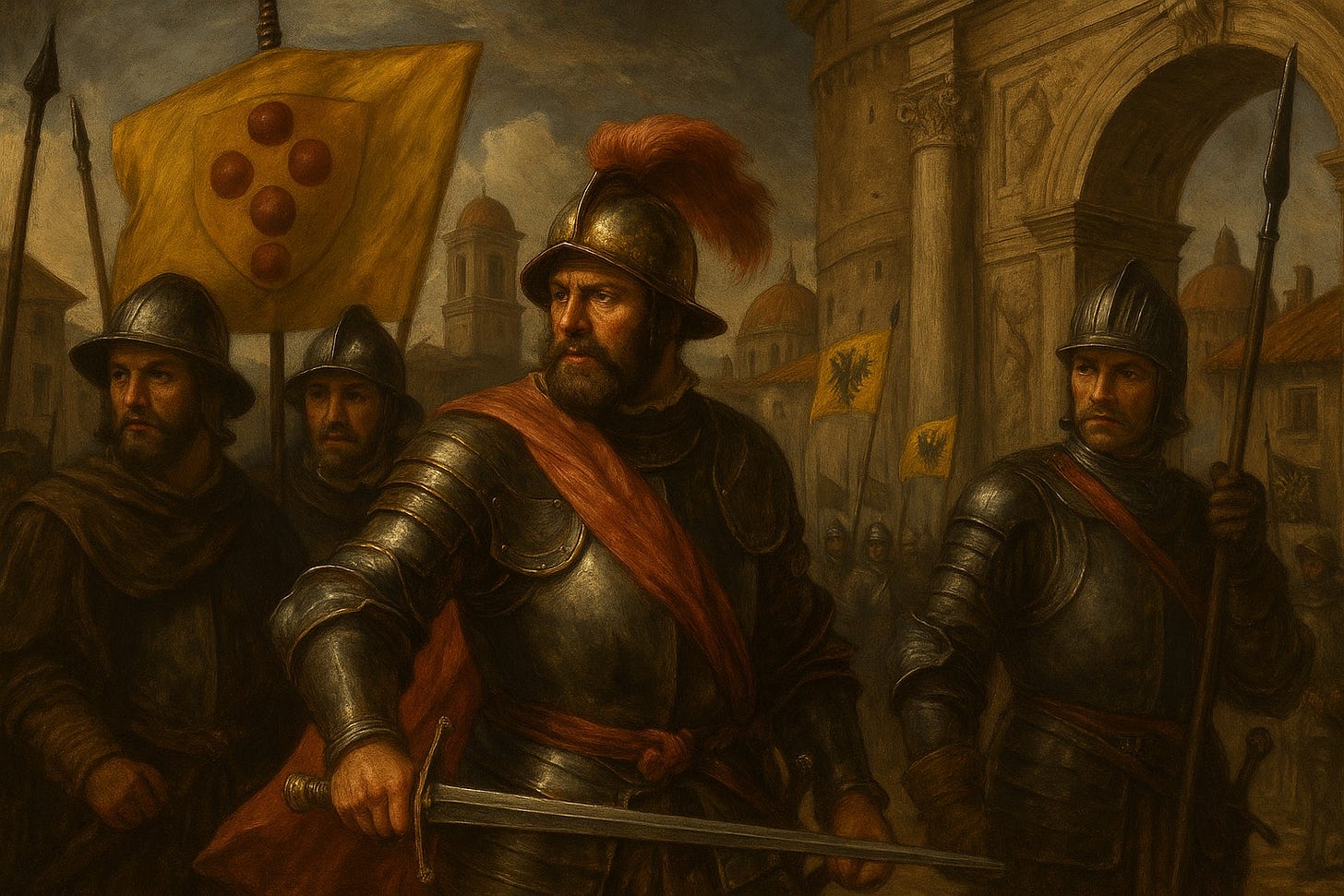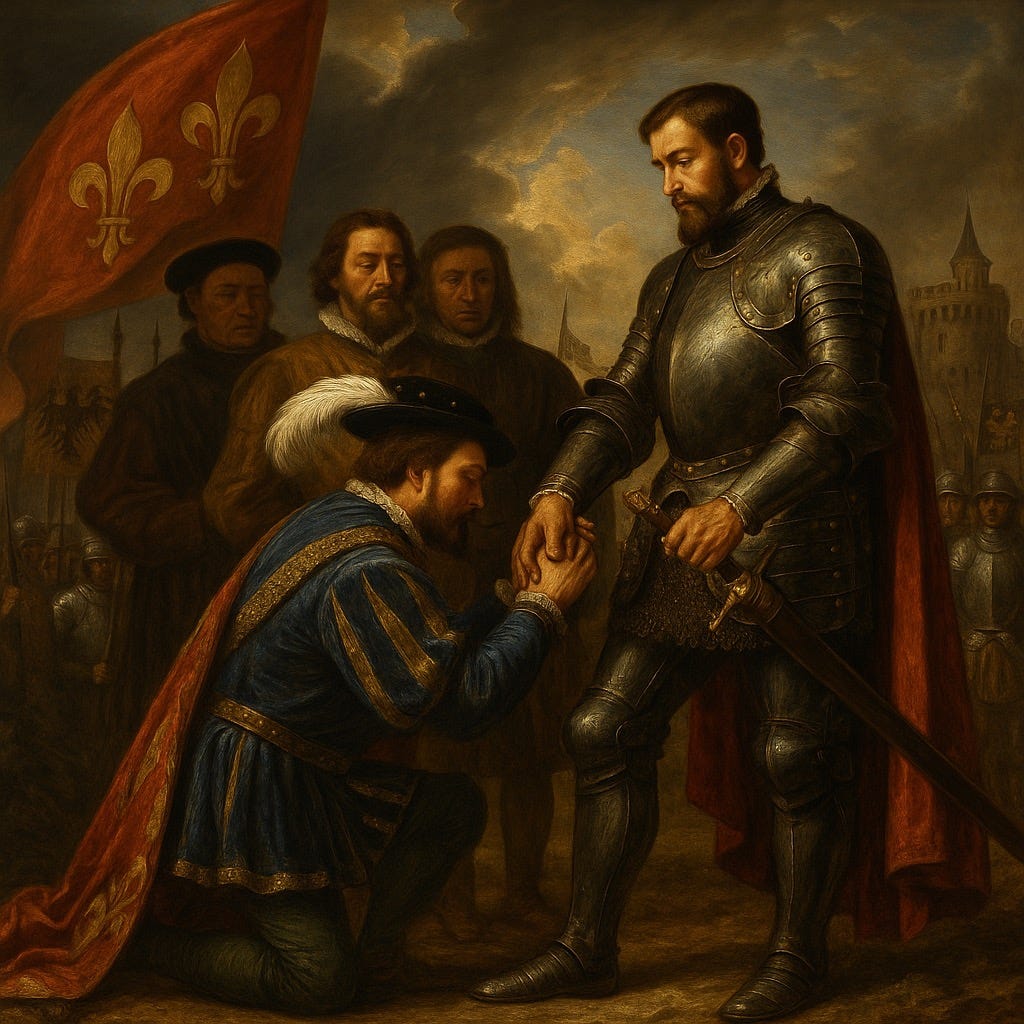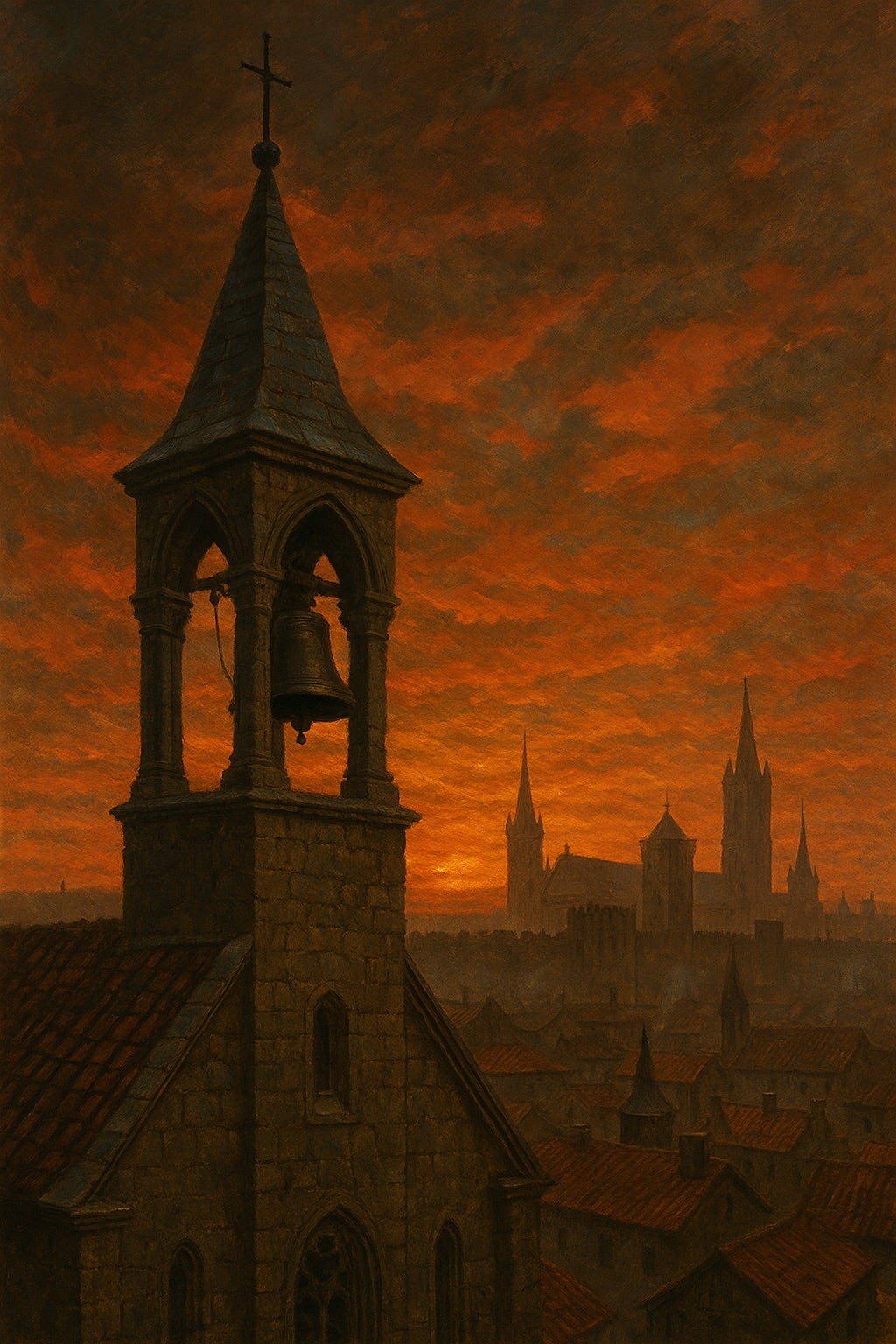From Sack to Sacrament: The Last Valois, The Italian Solution, and The First Imperium
Because history doesn’t repeat itself—it remixes.
Prologue: The Real Francis at Pavia
As we celebrated La Fête Nationale, The National Day of The French Republic, on the 14th of July, it might not have been so 500 years ago. In February 1525, Francis I, King of France, charged into legend—and disaster—outside the Italian city of Pavia, where his armies clashed with the combined forces of Charles V, Holy Roman Emperor, and Charles de Bourbon, the French turncoat who had sold his sword to the Empire.
Francis had invaded Italy to reclaim Milan, the eternal prize of French ambition in Lombardy. At first, things looked promising. He took Milan. He encamped comfortably. But he underestimated Imperial resolve and Bourbon’s ruthlessness. The French were outmaneuvered, outgunned, and encircled by a tighter force of Spanish arquebusiers, German landsknechts, and Imperial cavalry—all better trained for a modern battlefield.
The Battle of Pavia, fought on February 24, 1525, was a bloodbath for France’s nobility. The chivalric charge, still France’s pride, became a massacre. The Duke of Alençon fled. Bonnivet was killed. La Tremoille was wounded. Francis himself fought heroically but was thrown from his horse and surrounded by Spanish foot soldiers. His sword broken, he yielded.
Captured alive, he was taken to Madrid in chains.
From the gloom of a Spanish cell, Francis wrote to his mother:
“Tout est perdu, fors l’honneur et la vie qui est sauve.” (“All is lost save honor and life, which is safe.”)
But his honor would cost him everything else.
In 1526, after over a year of captivity, he signed the Treaty of Madrid, swearing to cede Burgundy to the Empire, renounce claims in Italy, and deliver his two young sons as hostages in exchange for his own release. The treaty was a masterclass in Habsburg power, but a diplomatic illusion.
Once freed, Francis reneged. He claimed the treaty was signed under duress and never intended to honor it. His sons were held in Spain for four years, bargaining chips in a war of dynasties and deception. The insult would define Franco-Habsburg animosity for decades.
Francis’s capture did not end his reign. But it marked the death of French dominance in Italy, the rise of Habsburg supremacy in Europe, and the new entrenchment of anti-French encirclement around the Valois crown.
But the situation could have been far graver…
The Corpse in the Mud and the Crown in the Fire
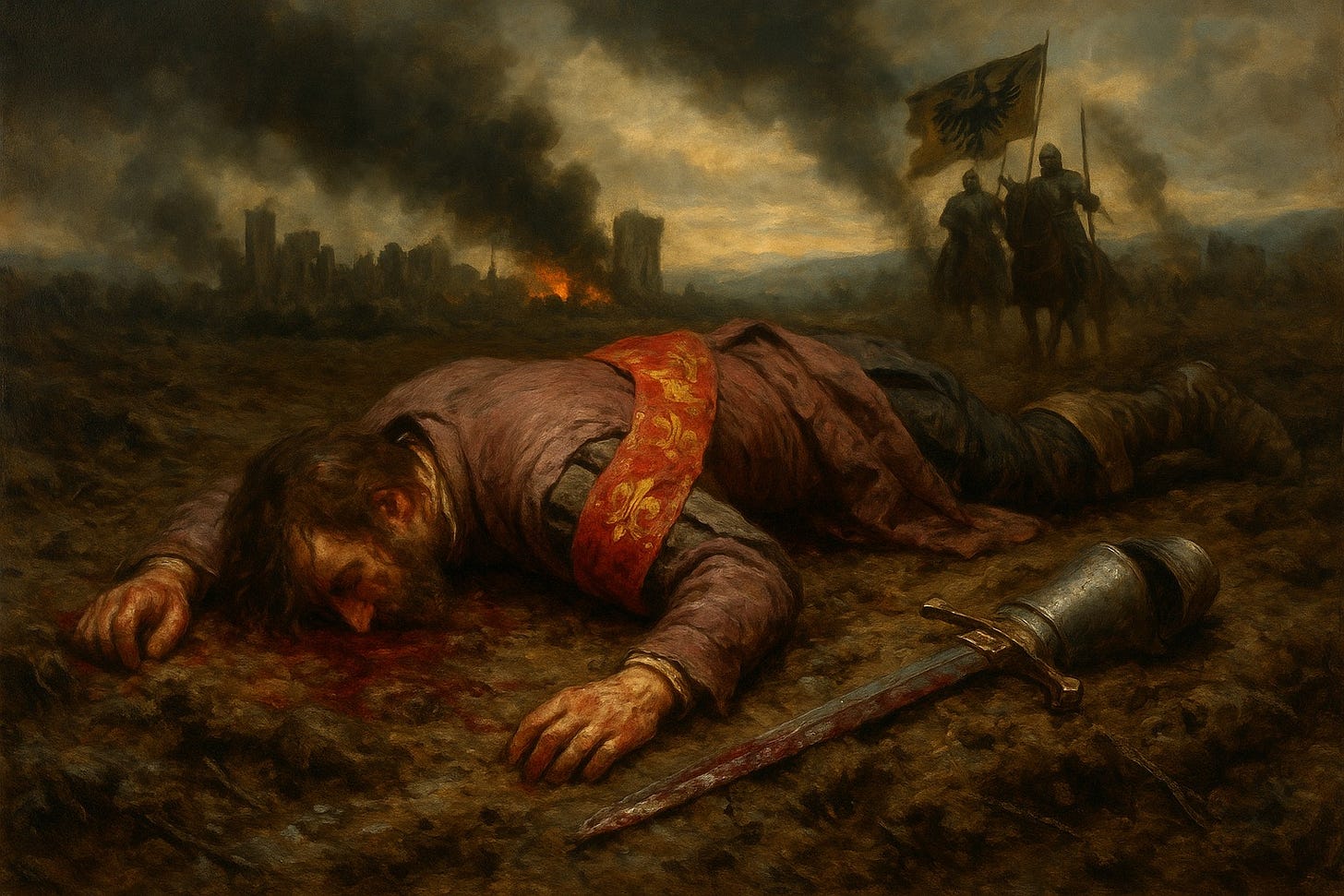
Francis I died in the mud, face down, pierced clean through the thigh and lungs by an Imperial halberd outside the ruined walls of Pavia. He did not go gently. He fought like a crowned beast—flailing, bleeding, roaring orders to a cavalry already scattered by Spanish tercio steel and German shot. But the final blow was not that of royal blood: it was a stomp to the skull by a landsknecht who didn’t recognize the fleur-de-lis.
His body was dragged into a barn. His signet ring was ripped off. His royal armor was sold in pieces by mutinous mercenaries before sunset. France had no king. Milan had no fear. And Europe had no brakes.
The Battle of Pavia, in this rerouted world, did not end with ransom. It ended with the end of France as a coherent force. The Valois line fractured before dusk. Word of the king’s death reached Paris in five days. In six, the Estates General was summoned from its long slumber and suspended all military campaigns. In seven, three separate regencies were claimed: one by the Guise uncles, one by Charles de Bourbon, and one by the Queen Mother who had no army and no plan.
France became a contested corpse. And vultures circled with parchment and sabers.
The Pisa Concord: Where Papal Ink Forged Iron Unity

In Florence, Clement VII—Giulio de’ Medici reborn as pontiff—watched the French collapse with holy calculation. Rome was still licking its wounds from the 1527 Sack. Clement had learned: never again would the Church be left unguarded. Never again would he rely on French kings who paraded as protectors and left the Vatican in ruin.
So, he also summoned. In this case, it would not be three Estates, but two crowns to a third altar. He summoned Charles V, the Emperor of nearly half the Earth. And he summoned Henry VIII, the English lion with a marital dilemma and an eye on France. They met not in Rome, but in Pisa—where Galileo would later study the stars—but where this generation rewrote the political heavens.
The Concord of Pisa (1530) was more than an accord. It was a consecrated strategy.
Clement offered: a guaranteed annulment for Henry’s marriage to Catherine. Full Papal blessing for Habsburg territorial claims in France and Italy. A Medici duchy raised to kingship in central Italy—Florence as royal, not republican.
Charles offered: relenting on his disapproval of Catherine being annulled from Henry in exchange for Mary being recognized as his sole heir. Imperial troops to restore Papal authority across the Papal States. Recognition of a Medici protectorate over Bologna, Urbino, and Ravenna.
Henry offered: Mary as the first in line in any succession scenario. English military support in Normandy and Brittany. Naval blockade of the French coast. A pledge to remain within the Catholic fold—if Rome delivered the goods.
Three pens. One mission. No dissent. The Papal seal was pressed into wax and blood. And Christendom became a trinity of empire, altar, and sword.
Operation Cap of Thorns: The Triple Invasion of France
French spring fields bloomed under foreign flags. Charles’s forces poured across the Pyrenees from Spain and the Alps, sweeping through Toulouseand Lyon like the wrath of Revelation. In the north, English ships shelled Calais and Rouen as troops landed under the command of Thomas Howard and Charles Brandon, their swords bearing scripture and sovereign decree.
From the southeast, Papal legates blessed a Venetian expedition that seized Marseille and installed a Medici provisional governor in Avignon.
The campaign was a cremation of the old Continental Order. Cities loyal to the Valois were razed. Bishops who refused the new order were stripped, paraded, and hung with broken censers. Every victory was a liturgy. Every atrocity was recorded in three languages—Latin, Castilian, and English—for posterity.
Catherine de’ Medici, barely 11, was declared “Regent of the Restoration” by the occupying Papal-Imperial forces. She ruled from Lyon, shadowed by Dominican confessors and Spanishadvisers. Her uncles in the Guise family fled to Lorraine.
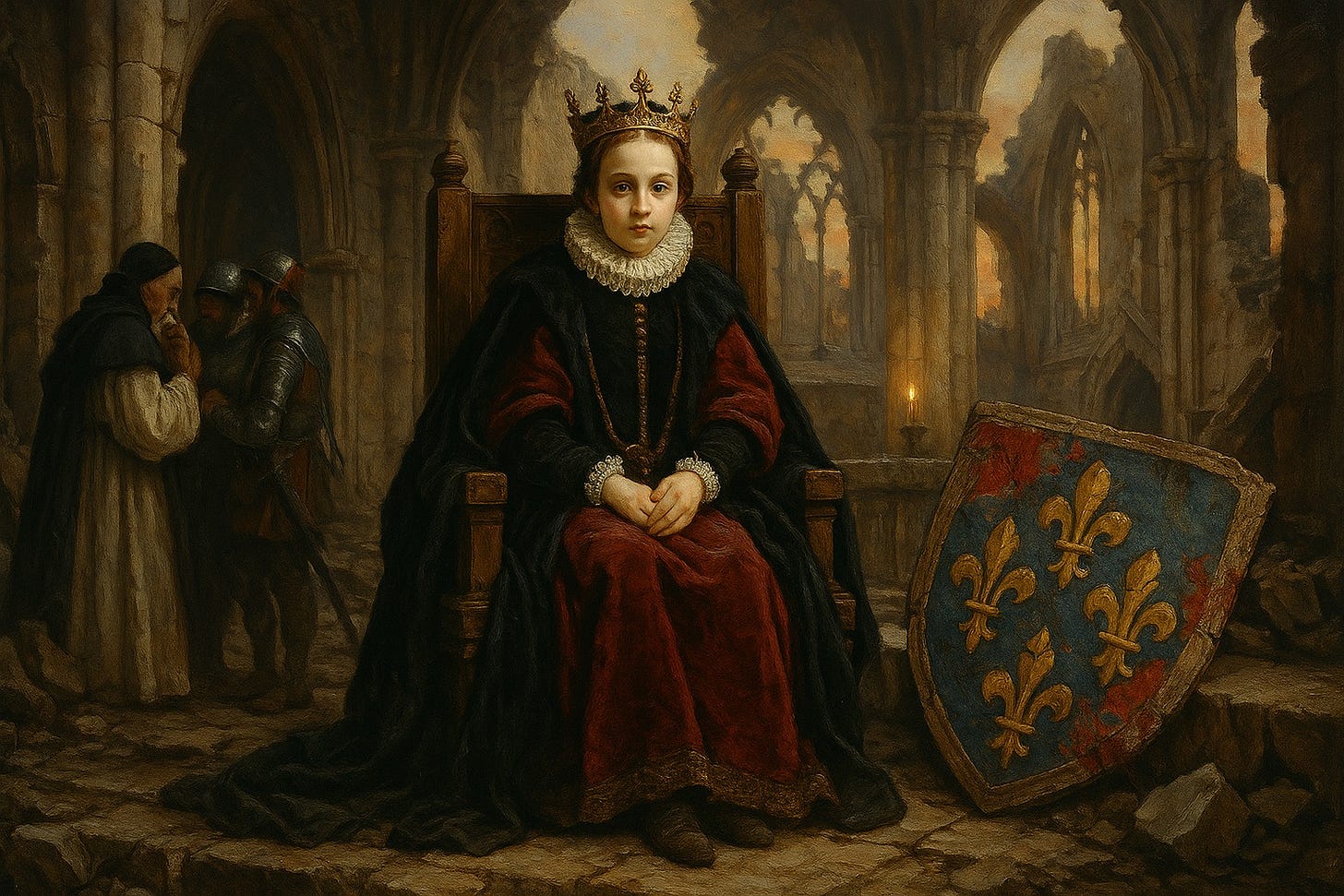
The Bourbons, ever the opportunists, swore fealty to Charles V and were granted Burgundy in return.
France died not in fires of revolution, but in rewritten maps by the three new European power guarantors.
England Remains Catholic—But Not Complacent

Henry VIII got his annulment. Fast. Swift enough to parade it in Canterbury before the ink dried. But Clement VII, knowing his leverage, offered more: a Habsburg princess as Henry’s next wife—Isabella of Austria, niece to Charles. The match was politically perfect. Henry married again, this time into a Catholic dynasty that locked him out of Protestant temptation. Anne Boleyn was relegated to obscure mistress with an even more obscured daughter: Elizabeth.
The English Reformation never happened. The monasteries remained. The liturgy held. Thomas More survived and became Archbishop of Canterbury in 1535. Anne Boleyn was eventually banished to Ireland once her uses were no longer needed, where she married an Anglo-Norman baron and wrote satirical verse for the Dublin court.
England became the northern arm of the Catholic Imperium. Not submissive, but aligned. Not Rome’s puppet, but its partner. Henry gained Calais and Normandy as protectorates. He styled himself “Defender of the Faith and Guardian of the North”. And the Pope—now stabilized, flanked by Habsburg gold and Medici policy—blessed every act with golden bulls and iron will.
The First Imperium: A Catholic World in Three Registers

By 1540, the landscape was fully remade.
Italy was consolidated. The Papal States, Florence, Milan, and Venice signed the Treaty of Ravenna—binding their forces under a “Foedus Regnorum Latinum” “Lega Latina dei Regni“ “Latin League of Realms.” No French troops would ever touch Milan again. No Protestant pamphlet would ever pass into Bologna. A unified front, military and theological, radiated from Rome to the Alps.
France was a triptych:
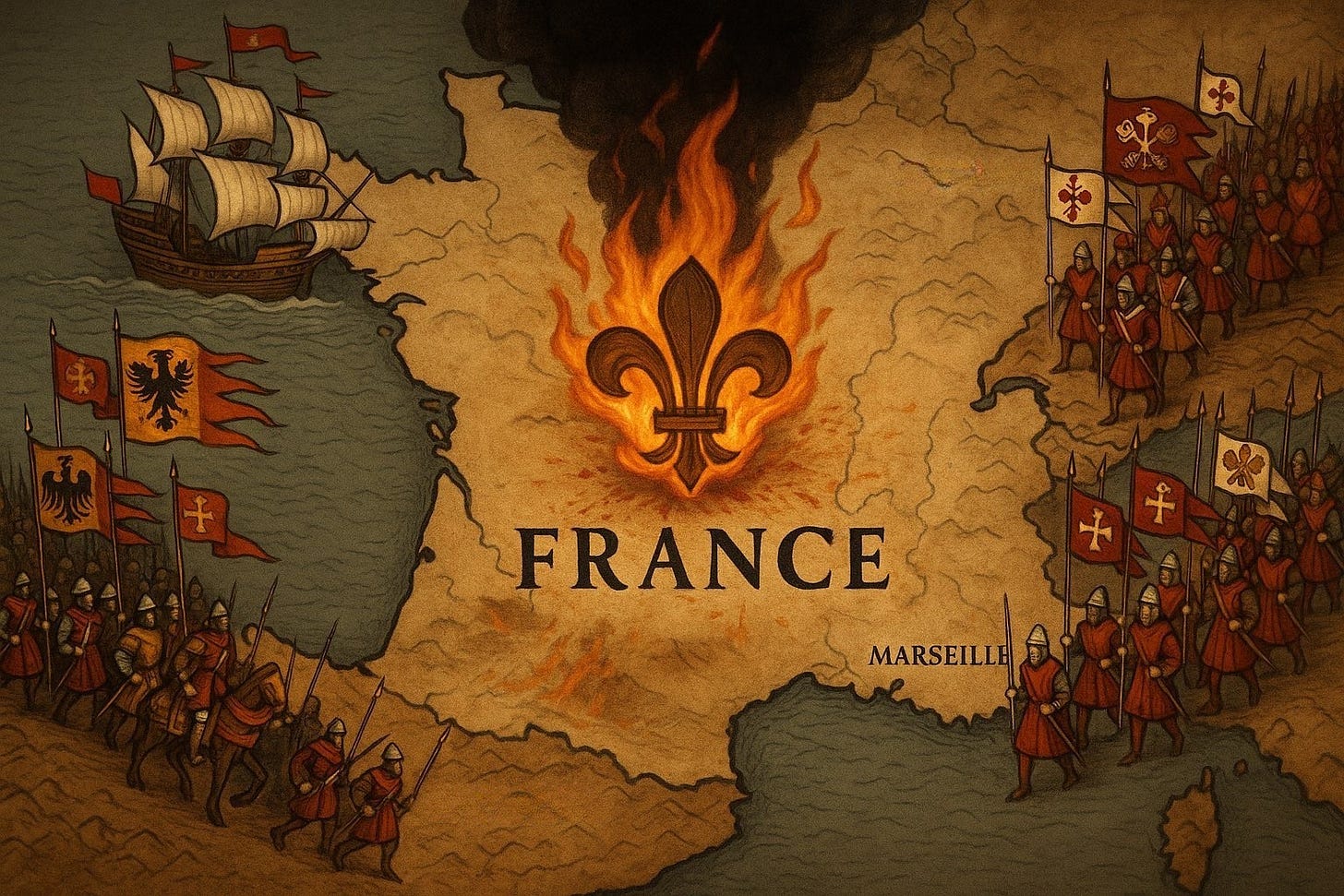
Northern France was an English protectorate governed from Rouen.
Central France was ruled by Bourbon-Habsburgloyalists in Dijon.
Southern France became a Medici-Papal Marchgoverned from Avignon by Medici bishops after Catherine’s regency ended but with Spanishtroops as insurance.
Germany remained volatile. Luther’s movement survived, but was locked into Saxony and Thuringia by 1545. The Diet of Worms was reaffirmed. Protestantism lost its missionary momentum. The Council of Ferrara (1542)—a Papal counter to Trent—codified doctrine with less paranoia and more pageantry. Reform came from within. Heresy was punished with fire, but doctrine was softened with diplomacy.
Spain, ever central, became the engine. Its galleons supplied the south. Its gold funded the bishops. Its alliance with Florence secured its legacy. And Charles V, crowned “Augustus et Pontifex Custos” in 1544, stood not only as Emperor of the Romans, but as Steward of the Faith.
The Last Valois and the Buried French Renaissance
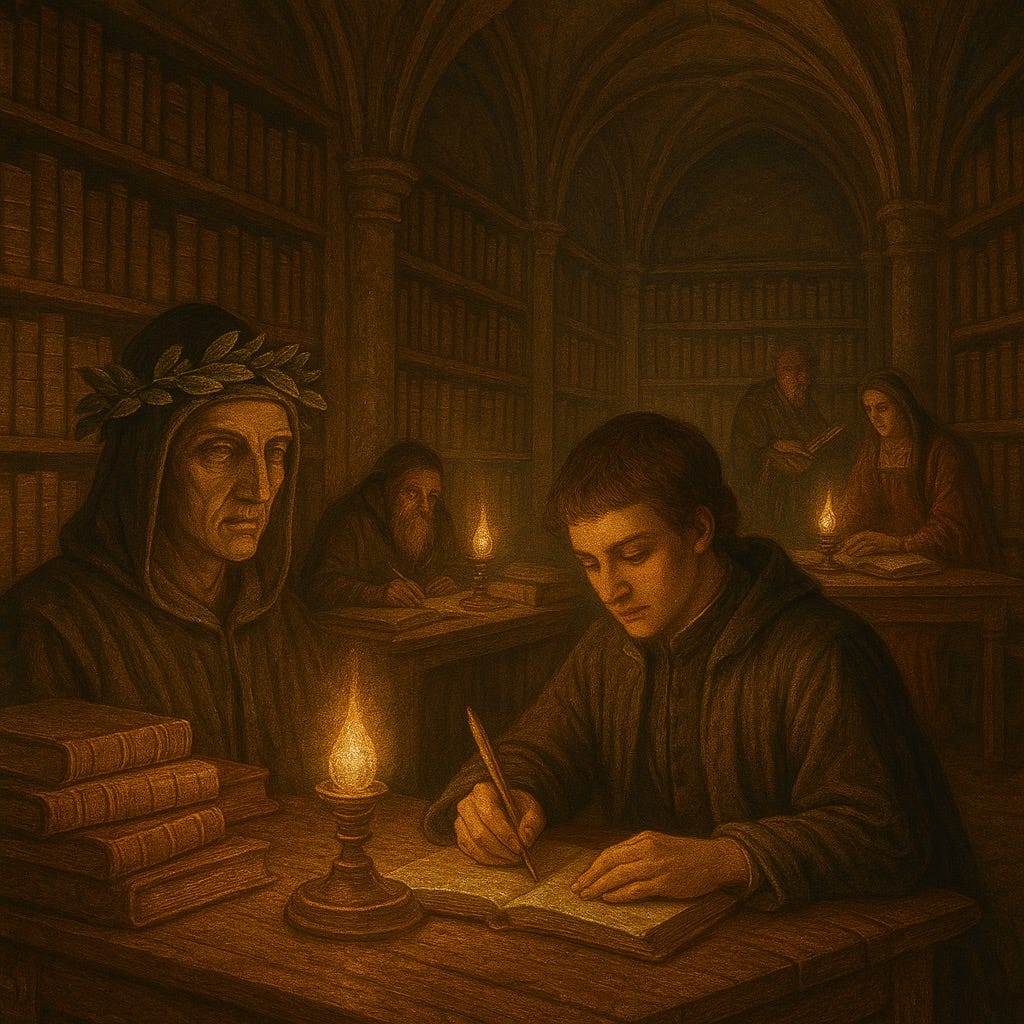
The Valois line ended in lore. The dauphin, frail and never crowned, died of illness in a castle outside Tours in 1537. His burial was secret. The Guiseissued a pamphlet calling it martyrdom. The Bourbons said nothing. France’s royal bloodline disappeared into silence and exile.
What France lost, Florence gained.
The French Renaissance, cut short by occupation, reblossomed in Italy. Leonardo’s legacy, instead of patronage from French courts, became institutionalized in Medici academies. The Florentine School opened The Biblioteca Pisana—housing all confiscated French manuscripts, treatises, and anatomical sketches. Thinkers who might have been Montaigne or Descartes instead became Micheli of Pisa, Domenico of Lyonnaiseorigin, Isabella Ferrarese.
The intellectual engine moved south again. The Enlightenment, centuries early, ignited under Catholic banners.
And the First Imperium, born of trauma, stitched Christendom into a single mythos: Rome at the center, Spain at the spine, England at the edge, and France divided by its past.
The Legacy of the Italian Solution
This was a reformatting of the world. The Concord of Pisa was the first post-national structure. It superseded borders. It replaced dynasties. It aligned religion, language, and law under a three-throned alignment.
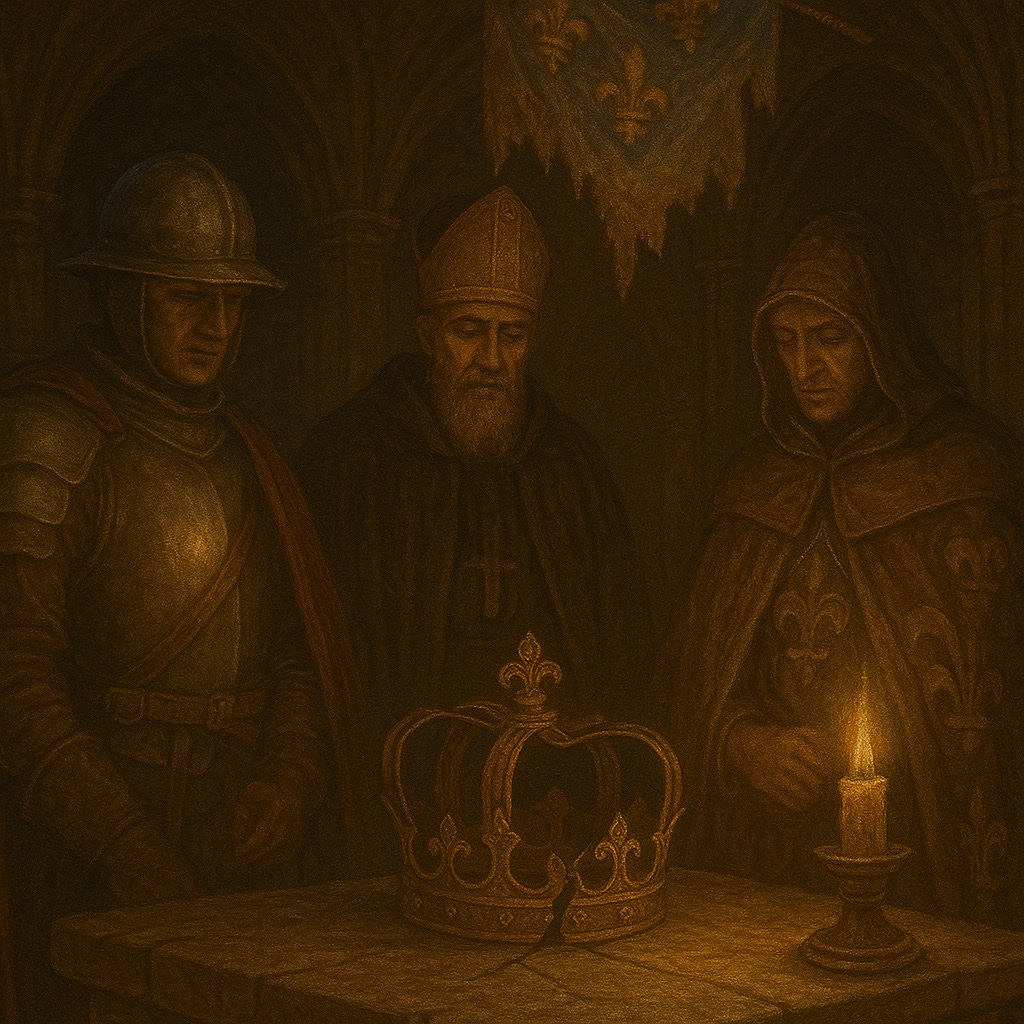
No single ruler dominated. The Medici ruled matters of the mind, the Habsburgs ruled the legions, the Tudors ruled the channel and trade. The Pope was no longer a hostage of factions. The Emperor was no longer besieged by French ambition. The English were no longer drifting toward isolation.
The Italian Wars ended with more than a peace. They ended with a council, a calendar, and a cultural firewall.
The world of modernity arrived—not through revolution, but through reconciliation imposed by swordpoint.
The Bell at Avignon
In 1569, a bell rang from the towers of Avignon. It marked forty years since the Concord. A new Pope, still of Medici blood, their power now etched into the throne of St Peter, presided over a Jubilee not in Rome, but in the south—symbol of France’s partial redemption and enduring division.

An envoy from England arrived bearing gifts. A delegation from the Austrian Netherlands brought wine and maps. A Medici cousin, because…there is always a Medici cousin, now titled “King of the Tiber,” gave a speech on the unity of humanism ordered under an Enlightened Papacy.
And behind them all, written in Latin and carved into the stone of Avignon’s gate, stood the motto of the new world:
“Ex Cinere Regis, Imperium Luxit.”
From the Ashes of the King, the Empire Shone.






